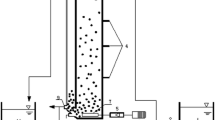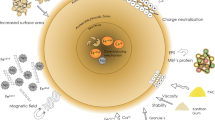Abstract
One of the main challenges for aerobic granular sludge in applications is its stability. In this study, the interaction between layered double hydroxide and extracellular polymeric substance was investigated and the mechanism for enhancing stability of aerobic granular sludge was also analyzed. Three sequencing batch reactors with nothing added (reactor 1), with layered double hydroxide added (reactor 2) and with metal ion solution added (reactor 3) were set up to investigate sludge developing characteristics and reactor performances, respectively. It was found that the mixed liquid suspended solids, sludge volume index and chemical oxygen demand removal efficiency of reactor 2 were better than those of reactors 1 and 3. At the same time, the concentrations of protein and polysaccharides extracted from the sludge in reactor 2 were also higher than those in reactors 1 and 3. This is possibly because with layered double hydroxide added, continuously and controllably released metal ions stimulate more extracellular polymeric substance production than the others and increase the hydrophobicity of the sludge. Fourier transform infrared spectroscopy characterization showed that the functional groups could combine with metal ions. A stable structure such as metal ions-extracellular polymeric substance–metal ion network may be formed and enhanced the granular sludge stability. This investigation provides a possibility for further application of layered double hydroxide on acceleration of sludge granulation and improvement in granule stability.





Similar content being viewed by others
Abbreviations
- LDH:
-
Layered double hydroxide
- EPS:
-
Extracellular polymeric substance
- AGS:
-
Aerobic granular sludge
- SBR:
-
Sequencing batch reactors
- MLSS:
-
Mixed liquid suspended solids
- SVI:
-
Sludge volume index
- COD:
-
Chemical oxygen demand
- PN:
-
Protein
- PS:
-
Polysaccharides
- OLR:
-
Organic loading rate
- FTIR:
-
Fourier transform infrared spectroscopy
References
Adav SS, Lee DJ (2008) Extraction of extracellular polymeric substances from aerobic granule with compact interior structure. J Hazard Mater 154:1120–1126
Badireddy AR et al (2010) Role of extracellular polymeric substances in bioflocculation of activated sludge microorganisms under glucose-controlled conditions. Water Res 44:4505–4516
Barth A (2000) The infrared absorption of amino acid side chains. Prog Biophys Mol Biol 74:141–173
Barth A, Zscherp C (2002) What vibrations tell about proteins. Q Rev Biophys 35:369–430
Cao XL et al (2014) Comparison of Mg2+ and Ca2+ enhancing anaerobic granulation in an expanded granular sludge-bed reactor. Sci China Chem 57:1596–1601
Clescerl LS (1998) Standard methods for the examination of water and wastewater 20th Ed. Am J Public Health Nations Health 4:113-X
Comte S, Guibaud G, Baudu M (2006) Relations between extraction protocols for activated sludge extracellular polymeric substances (EPS) and EPS complexation properties: part I. Comparison of the efficiency of eight EPS extraction methods. Enzyme Microbial Technol 38:237–245
Deng S, Wang L, Su H (2016) Role and influence of extracellular polymeric substances on the preparation of aerobic granular sludge. J Environ Manag 173:49–54
Dignac M-F et al (1998) Chemical description of extracellular polymers: implication on activated sludge floc structure. Water Sci Technol 38:45–53
Dubois M et al (1955) Colorimetric method for determination of sugars and related substances. Anal Chem 28:350–356
Fang HHP, Xu LC, Chan KY (2002) Effects of toxic metals and chemicals on biofilm and biocorrosion. Water Res 36:4709–4716
Frølund B, Griebe T, Nielsen PH (1995) Enzymatic activity in the activated-sludge floc matrix. Appl Microbiol Biotechnol 43:755–761
Hao W et al (2016) The effect of metal ions on the microbial attachment ability of flocculent activate sludge. Environ Technol 37:722–731
Kang H et al (2015) Intracrystalline structure and release pattern of ferulic acid intercalated into layered double hydroxide through various synthesis routes. Appl Clay Sci 112–113:32–39
Kavita K et al (2014) Characterisation and anti-biofilm activity of extracellular polymeric substances from Oceanobacillus iheyensis. Carbohydr Polym 101:29–35
Konczak B, Karcz J, Miksch K (2014) Influence of calcium, magnesium, and iron ions on aerobic granulation. Appl Biochem Biotechnol 174:2910–2918
Lee DJ et al (2010) Advances in aerobic granule formation and granule stability in the course of storage and reactor operation. Biotechnol Adv 28:919–934
Li XF et al (2008) Correlation between extracellular polymeric substances and aerobic biogranulation in membrane bioreactor. Sep Purif Technol 59:26–33
Li XM et al (2009) Enhanced aerobic sludge granulation in sequencing batch reactor by Mg2+ augmentation. Bioresour Technol 100:64–67
Lin YM et al (2015) Sustainable polysaccharide-based biomaterial recovered from waste aerobic granular sludge as a surface coating material. Sustain Mater Technol 4:24–29
Liu J (2014) Enhanced aerobic sludge granulation with layered double hydroxide. Biointerface Res Appl Chem 4:736–740
Liu Y, Liu QS (2006) Causes and control of filamentous growth in aerobic granular sludge sequencing batch reactors. Biotechnol Adv 24:115–127
Liu Y et al (2004) A thermodynamic interpretation of cell hydrophobicity in aerobic granulation. Appl Microbiol Biotechnol 64:410–415
Liu J et al (2013) Adsorption of bacteria onto layered double hydroxide particles to form biogranule-like aggregates. Appl Clay Sci 75–76:39–45
Liu J et al (2014a) Enhanced decolourisation of methylene blue by LDH-bacteria aggregates with bioregeneration. Chem Eng J 242:187–194
Liu Y et al (2014b) Regulation of aerobic granular sludge reformulation after granular sludge broken: effect of poly aluminum chloride (PAC). Bioresour Technol 158:201–208
Moghaddam SS, Moghaddam MRA (2016) Aerobic granular sludge for dye biodegradation in a sequencing batch reactor with anaerobic/aerobic cycles. CLEAN Soil Air Water 44:438–443
Ni SQ et al (2013) Effect of magnetic nanoparticles on the performance of activated sludge treatment system. Bioresour Technol 143:555–561
Ochoa-Herrera V et al (2011) Toxicity of copper(II) ions to microorganisms in biological wastewater treatment systems. Sci Total Environ 412–413:380–385
Ren TT et al (2008) Calcium spatial distribution in aerobic granules and its effects on granule structure, strength and bioactivity. Water Res 42:3343–3352
Seviour T et al (2009) Gel-forming exopolysaccharides explain basic differences between structures of aerobic sludge granules and floccular sludges. Water Res 43:4469–4478
Show KY, Lee DJ, Tay JH (2012) Aerobic granulation: advances and challenges. Appl Biochem Biotechnol 167:1622–1640
Su KZ, Yu HQ (2005) Formation and characterization of aerobic granules in a sequencing batch reactor treating soybean-processing wastewater. Environ Sci Technol 39:2818–2827
Sun H et al (2017) Role of layered double hydroxide in improving the stability of aerobic granular sludge. CLEAN Soil Air Water 45:1–7
Tang C et al (2013) Research advances in aerobic granule stability enhancement. Chem Ind Eng Prog 5:96–101
Wei D et al (2016) Extracellular polymeric substances for Zn(II) binding during its sorption process onto aerobic granular sludge. J Hazard Mater 301:407–415
Yan L et al (2015) Role and significance of extracellular polymeric substances from granular sludge for simultaneous removal of organic matter and ammonia nitrogen. Bioresour Technol 179:460–466
Yu HQ, Tay JH, Fang HHP (2001) The roles of calcium in sludge granulation during UASB reactor start-up. Water Res 35:1052–1060
Zhang L et al (2007) Role of extracellular protein in the formation and stability of aerobic granules. Enzyme Microbial Technol 41:551–557
Zhang Q, Hu J, Lee DJ (2016) Aerobic granular processes: current research trends. Bioresour Technol 210:74–80
Acknowledgements
This work was financially supported by the National Natural Science Foundation of China (51578329, 51778352) and the Program for Innovative Research Team in University (IRT13078).
Author information
Authors and Affiliations
Corresponding author
Additional information
Editorial responsibiility: Josef Trögl.
Rights and permissions
About this article
Cite this article
Xu, X., Liu, J. & Sun, H. Improving granular sludge stability via stimulation of extracellular polymeric substance production by adding layered double hydroxides. Int. J. Environ. Sci. Technol. 16, 987–994 (2019). https://doi.org/10.1007/s13762-018-1729-4
Received:
Revised:
Accepted:
Published:
Issue Date:
DOI: https://doi.org/10.1007/s13762-018-1729-4




